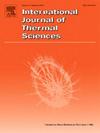Experimental study of the effect of using hybrid graphene and titanium oxide nanofluids in corrugated plate heat exchanger
IF 4.9
2区 工程技术
Q1 ENGINEERING, MECHANICAL
International Journal of Thermal Sciences
Pub Date : 2025-07-18
DOI:10.1016/j.ijthermalsci.2025.110125
引用次数: 0
Abstract
Heat exchangers play a critical role in various thermal systems, and enhancing their efficiency remains a major engineering challenge. Nanofluids have emerged as promising working fluids due to their superior thermal properties. This study experimentally investigates the thermal and hydraulic performance of a corrugated plate heat exchanger using hybrid nanofluids composed of graphene and titanium oxide nanoparticles dispersed in water. The motivation lies in combining the high thermal conductivity of graphene with the stability of titanium oxide to enhance heat transfer without significantly compromising flow characteristics. Nanofluids were prepared at four volume concentrations: 0.05 %, 0.1 %, 0.25 %, and 0.5 %, and tested at flow rates ranging from 2 to 5 L per minute. Key parameters including heat transfer rate, Nusselt number, friction factor, pressure drop, and exergy loss were analyzed. The results confirmed that hybrid nanofluids notably enhanced heat transfer performance, especially at lower flow rates. At 2 L/min, the heat transfer rate increased by 18.4 % with 0.05 % nanoparticle concentration, whereas at 5 L/min, the improvement was around 5 %. The friction factor increased substantially with higher nanoparticle loading rising from 0.956 for water to 9.07 for 0.5 % nanofluid at a Peclet number of 4000—yet this effect diminished at higher flow rates. Furthermore, exergy loss was consistently reduced by using nanofluids, though the benefit decreased with increasing flow rate. Overall, the findings suggest that hybrid nanofluids can significantly improve the thermal performance of corrugated plate heat exchangers.
石墨烯与氧化钛混合纳米流体在波纹板换热器中应用效果的实验研究
换热器在各种热系统中起着至关重要的作用,提高其效率仍然是一个重大的工程挑战。纳米流体由于其优越的热性能而成为有前途的工质。本研究利用分散在水中的石墨烯和氧化钛纳米颗粒组成的混合纳米流体,对波纹板换热器的热工性能和水力性能进行了实验研究。其动机在于将石墨烯的高导热性与氧化钛的稳定性结合起来,在不显著影响流动特性的情况下增强传热。制备了四种体积浓度的纳米流体:0.05%、0.1%、0.25%和0.5%,并在每分钟2 - 5l的流速范围内进行了测试。对传热速率、努塞尔数、摩擦系数、压降、火用损失等关键参数进行了分析。结果证实,混合纳米流体显著提高了传热性能,尤其是在低流速下。在2 L/min条件下,当纳米颗粒浓度为0.05%时,换热率提高了18.4%,而在5 L/min条件下,换热率提高了5%左右。随着纳米颗粒负载的增加,摩擦系数显著增加,当佩莱特数为4000时,水的摩擦系数从0.956上升到0.5%纳米流体的摩擦系数9.07,但在更高的流量下,这种影响减弱。此外,使用纳米流体可以持续降低火用损失,但效果会随着流量的增加而降低。综上所述,混合纳米流体可以显著改善波纹板换热器的热性能。
本文章由计算机程序翻译,如有差异,请以英文原文为准。
求助全文
约1分钟内获得全文
求助全文
来源期刊

International Journal of Thermal Sciences
工程技术-工程:机械
CiteScore
8.10
自引率
11.10%
发文量
531
审稿时长
55 days
期刊介绍:
The International Journal of Thermal Sciences is a journal devoted to the publication of fundamental studies on the physics of transfer processes in general, with an emphasis on thermal aspects and also applied research on various processes, energy systems and the environment. Articles are published in English and French, and are subject to peer review.
The fundamental subjects considered within the scope of the journal are:
* Heat and relevant mass transfer at all scales (nano, micro and macro) and in all types of material (heterogeneous, composites, biological,...) and fluid flow
* Forced, natural or mixed convection in reactive or non-reactive media
* Single or multi–phase fluid flow with or without phase change
* Near–and far–field radiative heat transfer
* Combined modes of heat transfer in complex systems (for example, plasmas, biological, geological,...)
* Multiscale modelling
The applied research topics include:
* Heat exchangers, heat pipes, cooling processes
* Transport phenomena taking place in industrial processes (chemical, food and agricultural, metallurgical, space and aeronautical, automobile industries)
* Nano–and micro–technology for energy, space, biosystems and devices
* Heat transport analysis in advanced systems
* Impact of energy–related processes on environment, and emerging energy systems
The study of thermophysical properties of materials and fluids, thermal measurement techniques, inverse methods, and the developments of experimental methods are within the scope of the International Journal of Thermal Sciences which also covers the modelling, and numerical methods applied to thermal transfer.
 求助内容:
求助内容: 应助结果提醒方式:
应助结果提醒方式:


